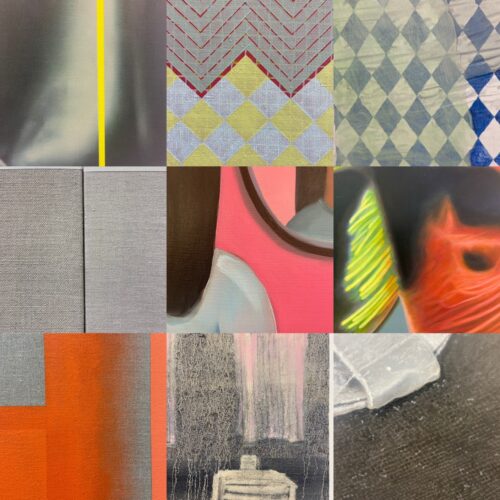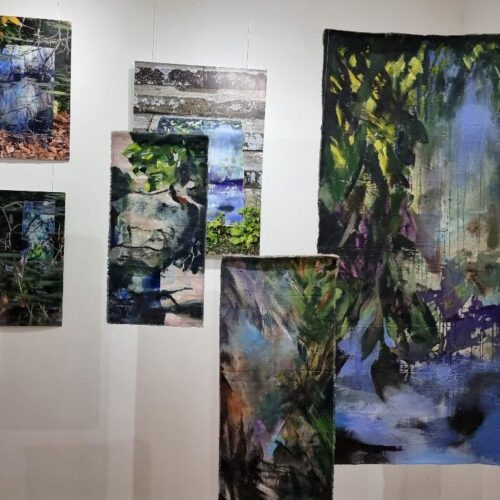
Manchester Study Visit: Ryan Gander
Ryan Gander occupies a place in British contemporary art somewhere between Mark Wallinger (who is more political), Grayson Perry (more political and more entertaining), and Jeremy Deller (more earnest). All of these artists are media-savvy, but Gander seems the most relaxed. We can see this in the videos that explain his work clearly and concisely scattered throughout the show.
He has no signature style — aside from it being beautifully realised —and some of his work is obscure while other pieces are more immediate and, at times, glib. That’s not necessarily a bad thing, though I could do without animatronic eyes that look back at me from the gallery wall.
To the casual viewer some of these works seem impenetrable, but rest assured, these works are all about something. This impenetrability is countered by his affability as the films in the show demonstrate. He’s happy to talk about his work with what seems to be disarming honesty. For me, it’s his work as a whole rather than specific pieces that probably asks the most interesting questions of the audience.

One large piece fills a gallery wall with different sized round glass sheets, each of which has a paint smeared on them. They’re messy and colourful (but the rhythmic display adds a measure of cleanliness to the work) and almost decorative. Each of these glass discs is, we’re told, a palette relating to a portrait of a person or group of people. These pictures have, apparently, been destroyed. If you want to wade through it, there is a sheet with all the (non)paintings’ details. It’s a strange work in that, if we believe him, Gander took time to make something that we can’t see and then displayed the paraphernalia relating to that work as the work. It seems at first like a one-line joke — something a lot of artists have fantasized about doing, but never have — but perhaps it is more profound. Do we believe the artist? Can we reconstruct the paintings in our head from the evidence of the palettes? Perhaps the palettes are portraits, too? This gap, between what is made/presented and our encounter with it is what I think he’s really interested in. My own taste (which is another issue) is for works that are complete, so I find this gap frustrating. I want the artist and especially the art work to stand up for something, but Gander’s work is too slippy for that. These palettes are visually pleasant enough, and they do force us to speculate on the look of the missing painting, but they never really escape their simple material quality.

Gander’s shifts between media and subject matter could be disorienting for someone seeing his work for the first time. It’s almost as if he’s made a one-man group show. It’s inevitable that this prolific approach – which is by no means arbitrary as he filters ideas over months and years until he’s happy with them – means that some pieces do hit home, compiling his ability to notice the poetic in everyday things and then hold interesting elements in tension. In this show it’s the three cast sculptures of dens made by his daughter. What were made as temporary structures in which to play and hide have become, through being transformed into marble, sepulchral and very permanent. There’s a profound melancholy about them, fixing as they do something improvised and youthful and turning it into something both literally and figuratively heavy.
If part of the point of his whole approach is to draw out a response from an audience then perhaps I should let the work percolate a little, which would mimic his studio process. Sometimes jokes can tell us profound truths, and when he gets it right the work can transcend the explanation that surrounds it, but at the moment I’m not captivated by the bulk of his work.
I will be returning to see this show as an OCA Study Visit and it would be great to mull over the issues with other artists. There’s something going on, I’m sure, but I can’t quite put my finger on it. Perhaps that’s the point. Join me on Saturday afternoon, the 13 September at Manchester Art Gallery.
Places are free to OCA students, to book yours email enquiries@oca-uk.com






Gander’s work is fascinating to me because he notices how situations and relationships in the observed world transcend their materiality. Everything has a narrative or history that may or may not be known. The artist reveals something about the narrative or potential in a situation, and it is then up to the viewer to use imagination to create fuller picture. Gander’s ideas are elegant, but the aesthetics of the objects and materials he uses seem to be more a matter of chance, or they are incidental. So as a visual artist, I find that aspect of his work frustrating.
Well said. There’s something to like and even admire, but something never quite adds up, to mind.
one of my favourite artists – I’m very jealous!!!
The unfettered use of materials and ‘styles’ makes the work feel disconnected and irrelevant.
Why irrelevant? Can’t artists shift between media and remain relevant? I think there is a style, albeit not one centred on a particular medium.
It has nothing to do with ‘shifting between media’. It is a case of the emperor’s new clothes.
That’s not what you wrote. You made a clear link between use of materials and styles and disconnection and irrelevance.
I’m suspicious of some of his work too, but am also wary of the idea of artists being seen as perpetrators of a kind of fraud. Artists I’ve met, even those whose work (or person) I have disliked intensely, always seem to be genuine. My problem with Gander is that he’s too prolific, but that might be an important part of his practice.
He notices stuff – trivial perhaps, but that’s okay – and finds a way of making something from that. Some work is opaque, and some isn’t. One of the slickest things in this show is a short video that purports to be an advert for a government agency. It’s ‘message’ is about creativity and so on, but that’s embedded in a bland and vapidly positivist product that doesn’t really get us anywhere. To me, that sort of thing needs taking on anywhere and everywhere.
Reading the end of that post I realise that it’s a little confusing. The video is deliberately vapid and he’s critiquing that. The point about it ‘not getting us anywhere’ is that these types of mission-statement films are banal. Gander is aping that language for effect.
To my mind Gander’s eclectic approach is a challenge to some aspects of the received wisdom as to what constitutes an artist-the idea that work progresses through stages, for instance, or that the message is in the medium. By refusing to comply, I feel that Gander opens up not only an interesting space for the viewer but also demands that we rethink practices such as art criticism and art history. I suppose I’m saying that for me the “not adding up” may be part of the point.
I thought I’d do a bit of research on the creativity video…for anyone wanting to view it its here
http://vimeo.com/78679580
It seems to have been commissioned from an advertising agency by Gander. http://www.kandhadvertising.co.uk/kandhadvertising/Imagineering.html
There’s a review of it here
http://artlifemagazine.com/art-exhibitions/ryan-gander-le-plateau-paris.htm#.U_9Cik10zBR
I personally have a strange liking for not knowing the truth of things, I quite like that there are gaps that leave a bit of room to have a bit of a laugh or feel a bit perplexed or get a sense of confusion even. But leaving that aside. I was just thinking that putting an advertising video into an art gallery is quite an interesting thing to do … the way in which we look at art compared to the way in which we look at advertising is so different, but without an awareness of that I could imagine (ha!) that it wouldn’t work as a critique for some?
I work as an art therapist in a palliative care setting. Some time ago I started noticing what was left behind after a work was created in the art therapy room, particularly the unintentional marks on the sheets i used to cover the table and also the paint left on the mixing plates. We were using disposable polystyrene plates for mixing. Perhaps because of the setting these ‘left overs’ had a particular significance. I dont know who it was who said that life happens in the moments between the ‘events’ of our lives. Also the painting plates were so vibrant and free sometimes in contrast to a work that someone had laboured over. Anyway for a period of a few months we started asking people if we could pin their plate on the wall and created an installation not unlike the one above. It was a great way of acknowledging the process rather than the product, which in art therapy may be quite private. It looked beautiful and it drew peoples attention to paint and abstraction in a different way.